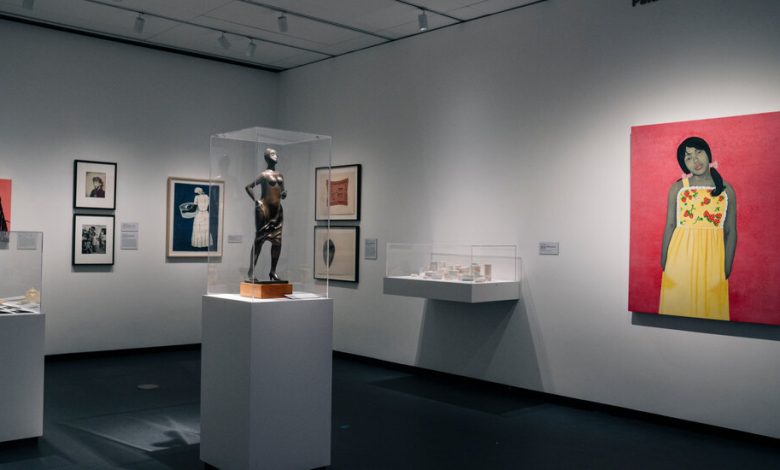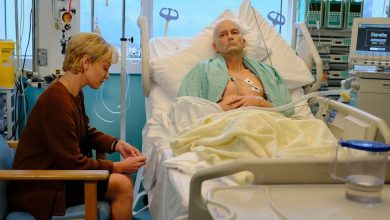Is a Women’s Museum Still Relevant?

More than one origin story surrounds the National Museum of Women in the Arts, an institution that is almost synonymous with its founder, Wilhelmina Holladay, who cut a legendary figure in Washington social circles.
According to official history, the first seed for the museum was planted in Europe in the late 1970s. It was in Vienna that Holladay and her husband, Wallace, discovered the work of Clara Peeters, a Flemish painter and contemporary of Rembrandt. Another encounter with Peeters followed at the Prado museum in Madrid. Yet when Holladay consulted H.W. Janson’s “History of Art,” a chronicle of Western painting, she could find no mention of Peeters — or any other woman artist.
This revelation led to Holladay’s life’s work: correcting the record by building an art collection that culminated in the first major museum in the country dedicated exclusively to women artists.
Former museum staff recall that she told another story: The Holladays were torn between two still-life paintings. Aesthetically, it was a close call, but one was available for one-quarter of the price. The art dealer explained that the discounted painting was made by a woman. As investors and collectors, the Holladays found their edge.
On Oct. 21, the National Museum of Women in the Arts reopens its doors after a two-year renovation. It will do so without its founder: Holladay died at 98 in March 2021, a few months before the hiatus. The museum was bound to emerge as a different institution, given the scope of the $67.5 million effort to restore its building, a former Masonic temple that once barred women from entering. But now it must manage without a matriarch whose sense of status and society has guided virtually every decision over the institution’s nearly 40-year history.
“Billie was the museum,” said Winton Holladay, Wilhelmina’s daughter-in-law, who replaced her as the museum’s board chair.
The museum’s collection of 6,000 artworks, ranging from Renaissance portraits to video installations, are all still tethered by a loose thread of gender. Rehung in a new, open format that emphasizes the flatiron frame of the 1908 building, the permanent collection hints at how the museum might step out from its founder’s shadow.
The social context for the museum has shifted dramatically, as well. Women are no longer completely frozen out of museum surveys or gallery shows. The women’s museum occupies more settled ground today than when it first opened in 1987, when Holladay’s vision was seen as ghettoizing by feminists and radical by elites.
“She liked the fact that the museum was centrist, as she called it, because you had a bunch of people angry on both sides,” said Susan Fisher Sterling, the museum’s director since 2008, referring to Holladay. “She felt that controversy ultimately helped to establish the museum as a place to be reckoned with.”
Even though there was no precedent for her museum, Holladay set her mind firmly on a vision of a nonpartisan Washington institution. “An art museum should not be concerned with politics, abortion or homosexuality,” she said the year it opened — not a startling view for a Rockefeller Republican, perhaps, but an example of how she distanced herself from the feminist firmament. At times her instincts led to conflicts with the staff. For example, its directors were not entitled to appoint members to the museum’s board, which remained fully within Holladay’s purview. (All were women, and part of Holladay’s social circle.)
“The staff senses that you’re not the final authority. I would make decisions and they would say, what does Mrs. Holladay think about this?” Judy L. Larson, the museum’s director from 2002 to 2007, said in a recent interview. “It cuts into your agency.”
The founder at times embraced the role of curator, too, suggesting shows that the staff would be expected to execute, or bristling at exhibitions that she felt crossed social boundaries. “Usually she gave us full reign to do what we wanted to do — until she saw the show,” Larson said. “Then it would be like, how did this happen?”
Holladay’s vision for the National Museum of Women in the Arts was elegant, embodied in the museum’s Great Hall. Now restored by the Baltimore architectural firm Sandra Vicchio & Associates, the building’s neoclassical proportions still speak to the Georgetown establishment to which Holladay belonged. A surreal chandelier by the Portuguese artist Joana Vasconcelos, suspended in the rotunda, now offsets the refined hall. The museum’s sole Frida Kahlo painting hangs in pride of place in the mezzanine, accessible by the grandiose twin marble staircases. (Or by elevator: The museum is now fully accessible in compliance with the Americans With Disabilities Act.)
Kahlo’s painting, “Self-Portrait Dedicated to Leon Trotsky” (1937), came to Holladay by way of the playwright, ambassador and doyen Clare Boothe Luce. She was visiting Kahlo in her Mexico City studio when the artist learned of Trotsky’s assassination. Kahlo was moved to destroy the canvas, but Luce persuaded her to part with it instead, according to Winton Holladay. Back in Washington, Luce summoned Wilhelmina Holladay to her Watergate apartment with the promise of a gift she wouldn’t believe.
Holladay cultivated benefactors from across Washington society and beyond. The museum’s first advisers included the sculptor Louise Nevelson, designer Diane von Furstenberg and socialite Lamia Khashoggi, wife of the billionaire arms dealer Adnan Khashoggi, then the world’s richest man.
“She was a complete force of nature,” the lobbyist and collector Tony Podesta said of Holladay. He has donated some 500 works to the museum. “I’m still at it,” he said. “I give the men to the National Gallery and the women to the women’s museum.”
For the reopening, the curators have shaken up the collection. A section called “Fiber Optics” includes a thread sculpture by Sonya Clark and a quilt by Faith Ringgold, for example, while “Home, Maker” features an 18th-century silver spoon by Hester Bateman alongside a cheeky 1990 tea set by the photographer Cindy Sherman. A curvaceous marble sculpture, Niki de Saint Phalle’s “Pregnant Nana” (1993), will greet viewers in the galleries — not the beloved Dutch Golden Age still-life paintings by Peeters.
“If I don’t have to do this parade through the ages, I can show anything,” the chief curator Kathryn Wat said.
The new view elevates artists that the museum championed long before they were discovered by other institutions, among them Amy Sherald, who painted Michelle Obama’s portrait, and Jaune Quick-to-See Smith, who had a retrospective at the Whitney Museum of American Art this year. Next fall, the women’s museum will mount the first East Coast survey of the Guyana-born artist Suchitra Mattai, exhibiting her mixed-media installations alongside historical artifacts from institutional collections that could shed light on her work.
Despite the museum’s ambition, its thematic approach could still be described as neutral — and at times it’s accessible to a fault. A gallery called “Seeing Red” pairs a 2022 sculpture by Alison Saar with a 1580 painting by Lavinia Fontana, for example, based on their shared hue.
“I’ll be frank with you,” Wat said. “When we kicked around the idea of having a gallery based on color, we looked at each other and asked, is this completely corny? Is this the lowest common denominator?”
With the renovation, the museum increased its gallery space by 15 percent, mostly by consolidating office areas. A special exhibition, “The Sky’s the Limit,” seems as though it were designed to show off the museum’s new musculature: Many works in this survey of large-scale sculpture by contemporary artists are suspended from the ceiling.
By no means is the museum leaving Holladay’s vision behind. Sterling said the work has barely begun: She points to a database compiled by the journalists Charlotte Burns and Julia Halperin that showed that artworks by female-identifying artists made up just 11 percent of U.S. museum acquisitions between 2008 and 2020. Art by women overall accounted for just 3 percent of global auction sales during this time. The figures for Black women artists are even bleaker.
“People in the art world always think we’re achieving parity faster than we are,” Sterling said. “We’re not even close to there, if 89 percent of acquisitions are men’s work.”
Rania Matar, a Boston photographer who also works in Beirut, is one of eight artists profiled in a series of short films on view in a new first-floor gallery. She said in an interview that the museum has shown her work twice before, including portraits she made of Lebanese and Palestinian girls living in refugee camps. One of the artist’s subjects (from “Rayven, Miami Beach, Florida”) came to the museum to see her portrait. Matar said the museum “treated her like royalty.”
Is the women’s museum still relevant?
To Matar, its value is unambiguous. “As a woman making work about women — most of my work focuses on growing up, growing older, motherhood — to be in the museum, it’s pretty important,” she said. “I would be upset if I weren’t.”





